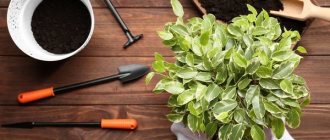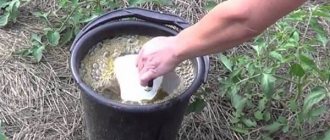Bulbs have a short season - the leaves and buds die off after flowering, and the plants “fall asleep” until next spring. One could forget about them, but in order for tulips, hazel grouse, and muscari to show themselves in all their glory next year and not degenerate over time, one has to tinker with them.
Many gardeners refuse to plant bulbs because of the labor-intensive digging. And, indeed, according to the classical growing technology, bulbs are dug up annually after the leaves turn yellow, sick and damaged ones are discarded, the baby is separated or the overgrown nest of bulbs is divided. Then dry well and store until planting in the fall.
For busy gardeners, however, there is a “loophole” - if the plants are planted at a sufficient distance, then they can not be dug up for an average of 4-5 years. In any case, annual digging is required for exotic tulips - from the Parrot, Fringed and many terry varieties. Also for the imperial hazel grouse, which in the middle zone does not have enough heat to set flower stalks, and drying and warming up in the sun increases the chances of flowering next season.
Types of bulbous flowers
Bulbous and corm plants include those that accumulate nutrients in the bulb (or corm, respectively) - a special formation of colorless leaves. It also serves vegetative, that is, non-seed propagation of plants. Some bulbs are renewed every year, others grow additional layers, increasing in size.
Bulbous plants belong to ephemeroids - that is, plants that are active for a very short time during the most favorable period for them, and then go into a dormant state. During this period, their above-ground part dies off, and nutrients are concentrated in the underground part. This is the essence of bulbous plants - they delight us with short, bright flowering, and then retain vitality in the bulb underground until the next decorative period.
Spring blooming bulbous flowers
This group includes a number of flowers, which are commonly called “snowdrops” - they bloom very early, as soon as the snow melts. These are galanthus (the same snowdrops), spring-flowering crocuses, scillas, snowman or chionodoxa, pushkinia, muscari, white flowers and other small-bulbous plants.
Also included in the spring-flowering group are species that bloom a little later, when the sun begins to actively warm up - these are tulips in the variety of all their varieties, everyone’s favorite daffodils, hyacinths, hazel grouse, iridodictiums, xyphiums or bulbous irises, as well as decorative onions.
Bulbous flowers blooming in summer and autumn
Autumn-blooming colchicums and crocuses should be planted in late summer - August-early September. But now is the time to plant a summer-blooming group. These are lilies, lycoris flakes, summer-blooming camassias, poultry plants, and onions. In some cases, it is permissible to plant early spring and spring flowering plants with a later flowering period, having previously organized a cooling period for them. However, you need to understand that in this case we are using forcing methods, which means that the flowering of tulips and hyacinths will be shorter and the bulb will be weakened.
Planting bulbous flowers
Bulbs grow better in the sun, but in light shade their flowering lasts longer. It is optimal to place it under the crowns of trees - before the leaves bloom, there is enough light for them, and in the fall the fallen leaves will mulch the plantings.
Groups of bulbous plants scattered among perennials look interesting, the foliage of which will subsequently hide plants that have lost their decorative appearance. Here, the distances between the bulbs can and should be increased, but the impression of a group should be created, and not solitary plants randomly scattered throughout the flower garden.
Sometimes tulips and daffodils are planted together with small bulbous bulbs; the bulbs are placed in the soil in layers at the required depth.
The planting depth depends on the size of the bulb - from the bottom to the soil surface there should be approximately three heights, on heavy soils - up to two heights. Even large bulbs should not be buried more than 20 cm - otherwise it will be difficult for the sprouts to break through. When planted shallowly, a lot of small children develop, often to the detriment of flowering.
However, for the propagation of valuable varieties, this technique may be justified. At the optimal depth, the number of babies will be smaller, but they themselves will be larger and of better quality.
It is convenient to plant a group of bulbs of the same variety in a special plastic basket - digging will be much more convenient, and at least from the bottom and sides the bulbs will be protected from rodents (however, they do not touch the poisonous bulbs of daffodils and colchicum). For sparse plantings it is convenient to use a bulb planter.
When planting bulbs, you should be wary of mechanical damage and spots on the outer scales - most often this is a symptom of fungal diseases. It doesn't hurt to treat the bulbs with a fungicide before planting.
The very first to be planted in the flower garden are kandyki and hazel grouse - their bulbs do not have protective covering scales and dry out quickly. As well as crocuses and autumn-blooming crocuses. Colchicum bulbs often bloom already on the counter - this is absolutely normal.
Then small bulbous plants are planted - their small bulbs are also prone to drying out, hyacinths, whose root system develops relatively slowly, and finally, daffodils and tulips.
Bulbs are planted from late August to early October. From the moment of planting until the top layer of soil freezes, 4-6 weeks should pass - during this time the root system will have time to develop, but the sprouts will not break through to the surface of the soil. If the sprouts try to break through, then mulch the plantings with dry leaves. During the long autumn, bulbous plants can be planted as long as the weather permits. But if the soil has already set, then it makes sense to start forcing, enjoy the flowering of the bulbs in winter and plant the plants in the flower garden a year later.
Growing tulips and daffodils indoors
It can be with or without forcing. But in both cases, tulips and daffodils need to be supplied with the necessary substances. When and what to feed flowers? It is enough to fertilize tulips and daffodils three times during the growing season. Do not need anymore. Excessive feeding can damage the flower.
It is not recommended to fertilize flowers indoors with organic matter. After all, various pathogens can get in with it. And the smell will not please you and your loved ones.
Feeding and watering bulbous flowers
Feeding and watering are an important component of comprehensive care for bulbous plants. Early flowering bulbs, which receive sufficient moisture for growth from melting snow, do not need to be watered until flowering begins. However, those bulbous plants that bloom in summer and autumn need additional watering, especially during dry periods when there is no rain. Watering should be done abundantly to saturate the deep-lying roots with moisture. A sufficient amount of moisture is important for bulbous plants even after flowering, so faded plants are watered regularly until the foliage turns yellow.
Over time, the reserves of nutrients in the soil are depleted, and fertilizers are used to replenish them, as well as to improve the soil structure. To do this, you can use organic fertilizers: manure, bird droppings, peat, compost. In addition to organic fertilizers, complex mineral fertilizers are applied to bulbous plants: ammonium nitrate, superphosphate, potassium salts.
Wood ash is a very good potassium fertilizer. Fertilization with nitrogen-containing preparations in combination with potassium is useful for increasing the yield of full-fledged bulbs, the size of the stem, the size of the flowers, and accelerates the onset of flowering. The absorption of nutrients by the bulbs begins in the fall, simultaneously with the growth of roots. The better the root system is developed, the more actively it absorbs nutrients in autumn and spring, which means that the plant will be healthy and strong.
Typically, phosphorus and potassium fertilizers are applied at full rates when preparing the soil for planting, and nitrogen fertilizers are applied when planting bulbs. In addition, during budding and at the beginning of flowering, bulbs need to be fed with a full complex of mineral fertilizers at the rate of 15–20 g per 10 liters of water, and after flowering - with a mixture of potassium and phosphorus fertilizers.
Fertilizing in the fall
Autumn fertilizing should be done when planting new bulbs. When carrying out this, remember that bulbous plants have a short fibrous root system, so they absorb substances that are located only next to them. Strong organic fertilizers (manure, compost, humus) can burn the roots that are beginning to form and lead to rotting of the bottom. They must be used carefully.
When choosing fertilizers for flowers, both annual primroses and perennial bulbous ones, you should pay attention to ammonium nitrate and fertilizers with a high nitrogen content. They provide a good formation of “babies” on the bulbs, increase survival rate and promote full flowering.
To dig up or not to dig up bulbous flowers
This point raises many questions, although everything is quite simple. Let's figure out whether it's worth digging up tulips or daffodil bulbs to save them until spring.
Small bulbous plants - crocuses, muscari, galanthus, pushkinia - do not require annual digging. Like daffodils and botanical tulips. Their transplantation and division of the clump is carried out every 3-5 years. The need for replanting is due to the fact that the planting becomes excessively thick and the plants experience a nutritional deficiency. And also with the fact that during reproduction, new bulbs are formed in the bottom area, which means deeper and deeper. Over time, they go to a depth that prevents the normal existence of the plant. To preserve the same daffodil bulbs until spring, they should be dug up periodically.
But the bulbs of varietal tulips need to be dug up annually - after flowering has completed and the leaves have withered. This point is of key importance for the preservation of the bulb and the development of the plant. Indeed, there is a great temptation to dig up the bulbs while the leaves are still intact. Firstly, you can see where to dig, and secondly, you want to remove the plants before they completely lose their decorative value. But the time has not yet come to dig up tulips. The period after flowering is very important for the plant - now nutrients accumulate in the bulb, it is renewed and divided. It is necessary to dig up tulip bulbs only after the leaves have withered.
Also, hyacinth, iridodictium, xyphium, and decorative onions need annual digging.
Regular digging of these plants is important to imitate nature's natural cycles and because our wet, cold summers often cause the bulbs to rot. Let’s not forget about the southern species that do not winter with us. We dig them up in the fall - before frost sets in. In contact with
Reproduction methods
Primrose is propagated using seeds, cuttings or division into parts. Seeds are planted in winter, propagation by vegetative methods is carried out from June to July.
Seeds
Primrose is propagated by seeds in winter, immediately after collection. If seeds have been stored for more than a month, their germination capacity is partially reduced and germination time increases. Storage throughout the season reduces the probability of germination by 70-80%.
Primrose sprouts
How to sow correctly:
- It is necessary to prepare the substrate for planting in advance; it consists of leaf soil, cleaned and disinfected sand and peat soil in a 1:1:1 ratio;
- The earth mixture is poured into a small container of sufficient area;
- The seeds are evenly distributed over the surface of the earth and sprinkled on top. There is no need to bury them, as this will make it more difficult for them to germinate;
- The container with soil should be covered with glass or plastic, you can cover it with cling film. The container is placed in a cool room, the air temperature should not exceed 15-19°C;
- You can transplant the sprouts into separate containers when several leaves have grown.
Usually, when sowing in autumn, sprouts appear within 3-5 months; when planting in spring, the seeds germinate already on 25-30 days.
Cuttings
You can get the required number of cuttings after trimming the flower. Primrose cuttings are carried out if the flower is small in size or has a weak leaf rosette, and it is not possible to divide the bush in half. How to take cuttings correctly:
- From the base of the flower near the roots you need to cut off a leaf with a petiole with a sharp knife;
- A layer of peat soil is poured into the planting container, and 2 times less coarse sand is poured on top;
- The cutting must be placed in the prepared mixture; it must stand at an angle and be buried 2-3 cm into the ground. The soil must be irrigated abundantly with water;
- The container with cuttings is covered with film or glass. The air temperature in the room should be within 15-18oC.
Every day the film is opened to ventilate and water the soil. Rooting takes 80-120 days, during which time roots and small leaves will grow. The plant is transplanted into a separate pot with soil for primrose. Flowering will begin no earlier than in 5-6 months.
Dividing the bush
A more common method of propagating primrose is by dividing the bush. Plants can be divided at the age of 3-4 years. The procedure is carried out only 7-14 days after the end of the flowering season. How to properly divide a bush into parts:
- The primrose needs to be carefully removed from the pot, the roots shaken off the ground;
- The roots must be clean; to do this, they are washed with cold water;
- With a well-sharpened knife, the primrose is divided into several parts, each of them should have a growth point - a piece of the main shoot;
- All side cuts must be sprinkled with coal powder or ash;
- The cut bush must be planted immediately, otherwise it may dry out. A substrate for planting primrose is poured into a low box, into which the cut parts are placed. The earth needs to be watered;
- The top of the box is covered with glass or covered with film; it should be kept in a bright room at a temperature no higher than 19°C. Every day the soil is ventilated and watered with a small amount of water.
After 15-20 days, the plants are transplanted into separate pots.
Note! The soil should be moist, but not soggy. If the container is covered with a stack, excessive moisture will provoke the development of fungus or rotting of the roots.











